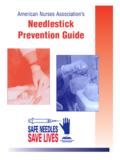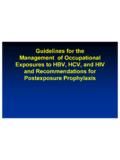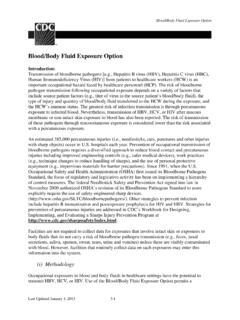Transcription of Guideline for management of occupational exposure to …
1 Guideline management of occupational exposure to blood and body fluids 2017 Table of Contents 1. Purpose .. 2 2. Scope .. 2 3. Related documents .. 2 4. Guideline for management of occupational exposure to blood and body fluids .. 3 General requirements .. 3 Immediate care of the exposed person .. 3 Risk 4 The exposure .. 6 The source .. 6 Unknown source .. 7 The exposed person .. 7 HIV point of care testing (PoCT) .. 7 Treatment of the exposed person .. 8 Human immunodeficiency virus (HIV) .. 8 HIV post- exposure prophylaxis (PEP) .. 9 PEP starter packs .. 10 Hepatitis B virus (HBV).
2 11 HBV PEP with hepatitis B immunoglobulin .. 12 Hepatitis C virus (HCV) .. 14 Care when the exposed person is a patient .. 15 5. References .. 16 6. For additional information see .. 17 7. Appendices .. 18 Attachment 1: Expert information network .. 18 Attachment 2: management of blood and body fluid exposures .. 19 Attachment 3: Guidelines for HIV and HCV pre and post 20 Attachment 4: Post- exposure prophylaxis (PEP) information sheet .. 23 8. Definitions of terms used in the Guideline .. 25 9. Document approval details .. 27 10. Version control .. 27 1. Purpose This Guideline provides recommendations regarding best practice to support the immediate assessment, management and follow-up of individuals who have been exposed (or suspect they have been exposed) to blood borne viruses (BBV), and recommendations for initiation of post- exposure prophylaxis (PEP) in occupational settings.
3 occupational exposures to blood and body fluids in healthcare settings have the potential to transmit hepatitis B virus (HBV), hepatitis C virus (HCV), and/or human immunodeficiency virus (HIV). An exposure that might place a healthcare worker at risk of HBV, HCV or HIV infection is defined as: a percutaneous injury (for example a needlestick or cut with sharp object); or contact of mucous membranes or non-intact skin with blood, tissue or other bodily fluids that are potentially For non-o ccupational exposures these guidelines should be read in conjunction with : Post- exposure prophylaxis after non- occupational and occupational exposure to HIV: National guidelines 2.
4 Sco pe This Guideline provides information for all Queensland public health system employees (permanent, temporary and casual) and all organisations and individuals acting as its agents (including Visiting Medical Officers and other partners, contractors, consultants, volunteers and students/trainees). 3. Related documents Standards, procedures, guidelines Post- exposure prophylaxis after non- occupational and occupational exposure to HIV: National guidelines management of human immunodeficiency virus (HIV), hepatitis B virus and hepatitis C virus infected healthcare workers management of occupational exposure to blood and body fluids 2017 -2- 4.
5 Guideline for management of occupational exposure to blood and body fluids General requirements Facilities should ensure: local systems are in place for reporting and managing exposures of healthcare workers (HCW) to blood and body fluids processes are in place to ensure that healthcare workers whose work places them at risk of direct contact with blood or body substances provide evidence of vaccination or proof that they are not susceptible to hepatitis B all staff receive education regarding the appropriate use of standard precautions at induction and again annually an emergency system is in place for the management of occupational and non- occupational exposures to BBVs.
6 The system should identify a local contact and a specialist in infectious diseases as a resource person for that facility (Attachment 1 includes contact details for the expert information network). This system and contact numbers should be prominently displayed. Immediate care of the exposed person Immediately following exposure to blood or body fluids, it is recommended that the exposed person undertakes the following steps as soon as possible: wash wounds and skin sites that have been in contact with blood or body fluids with soap and water2 - apply a sterile dressing as necessary, and apply pressure through the dressing if bleeding is still occurring do not squeeze or rub the injury site1 if blood gets on the skin, irrespective of whether there are cuts or abrasions, wash well with soap and water irrigate mucous membranes and eyes (remove contact lenses) with water or normal saline3 - if eyes are contaminated, rinse while they are open, gently but thoroughly (for at least 30 seconds)
7 With water or normal saline4 - if blood or body fluids get in the mouth, spit them out and then rinse the mouth with water several times4 if clothing is contaminated, remove clothing and shower if When water is not available, use of non-water cleanser or antiseptic should replace the use of soap and water for washing cuts or punctures of the skin or intact skin. 4 The application of strong solutions (for example, bleach or iodine) to wounds or skin sites is not For human bites, the clinical evaluation should include the possibility that both the person bitten and the person who inflicted the bite were exposed to The exposed person should inform an appropriate person ( supervisor or manager) as soon as possible after the exposure so assessment and follow-up can be undertaken in a timely manner.
8 After reporting the incident, the worker should be released from duty so that an immediate risk assessment can be performed. management of occupational exposure to blood and body fluids 2017 -3- Risk assessment The designated person should assess and document the risk as soon as possible after every incident of occupational exposure , referring to the expert information network as required (see attachment 1). This should include: information about the exposure - date and time of the exposure - type of exposure including blood or body fluid involved information about the source person - the BBV status of the source individual - demographic factors gender, country of origin etc.
9 Information about the exposed person - the status of the exposed person with respect to BBVs, including vaccination - pregnancy risk and lactation - medical history. In an occupational setting a risk assessment should be conducted on the basis of the type of exposure and the amount and type of infectious material involved. A risk assessment should be undertaken based on the degree of exposure , guided by the information in Table 1 and Table 2. Table 1: exposure classification of an occupational exposure exposure Classification Risk Factors Follow up exposure injection of large volume of blood/body fluid (>1mL) parenteral exposure to laboratory specimens containing high titre of virus any skin penetrating injury - with a needle contaminated with blood or body fluid - which causes bleeding and is produced by an instrument that is visibly contaminated with blood or body fluid - mucous membrane or conjunctival contact with blood - human bite or scratch with blood exposure prior (not fresh)
10 Wound or skin lesion contaminated with blood or body fluid immediately identify the source individual (if known) as a minimum undertake baseline screening of the exposed person provide follow up as per section titled: Treatment of the exposed person seek advice from the expert information network (attachment 1) as appropriate management of occupational exposure to blood and body fluids 2017 -4- in laboratory settings, any direct inoculation with HIV tissue or material, or material likely to contain HIV, HBV or HCV not included above Doubtful exposure intradermal ( superficial )
















